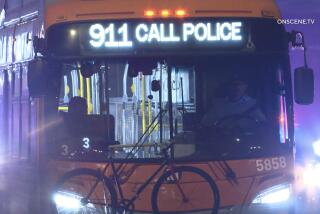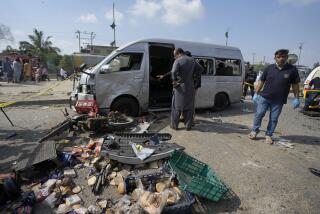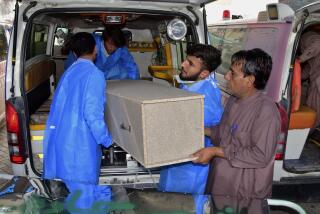Hijackers Panic, Kill 15 on Jet : Fire Blindly in Cabin; Troops Storm Plane
KARACHI, Pakistan — A 16-hour hijacking ordeal reached a bloody conclusion late Friday when Arabs who had hijacked a Pan American World Airways jumbo jet at Karachi International Airport began firing automatic weapons at the passengers, and Pakistan army commandos stormed aboard and captured the plane.
At least 14 of the 384 hostages on board the plane were killed in the hijacking’s final minutes, another passenger was slain earlier by the terrorists and about 127 people were wounded, according to airline and Pakistani officials. The Karachi newspaper Dawn reported 30 dead, based on reports from reporters at local hospitals.
Khurshid Anwar Mirza, Pakistan’s civil aviation director, said two terrorists were killed and two were captured by the commandos. A fifth hijacker may have been aboard posing as a passenger, Mirza said, adding that authorities are investigating whether one critically wounded man was part of the gang.
“The two guys who are alive and kicking are being questioned,” Mirza said.
The hijackers, who were armed with hand grenades and automatic weapons, apparently started shooting in panic after the plane’s auxiliary power unit failed as it ran out of fuel and the lights dimmed on the Boeing 747. Officials and passengers here speculated that the gunmen assumed the lights had been purposely turned off to prepare for an attack by the commandos.
Earlier, a businessman from California was shot by the hijackers and his body was dropped onto the tarmac. The shooting came after the leader of the hijackers, who called himself Mustafa, had warned that he would kill one American passenger every 10 minutes until an Arabic-speaking crew was provided to fly the plane to Larnaca, Cyprus.
Rajesh Kumar, 29, of Huntington Beach, a Kenyan-born real estate investor who had recently become a naturalized American citizen, was apparently singled out by the hijackers because of his nationality and shot in the head. He died several hours later in surgery at Jinnah Hospital here.
In New York, Martin R. Shugrue, vice chairman and chief operating officer of Pan Am, said the dead included both passengers and airline staff, among them a mechanic who had maintained radio communication between the hijackers and the authorities through the ordeal. He declined to identify any of the victims, pending notification of next of kin.
Figures on Americans Vary
Pan Am officials in New York said 44 Americans were on board the plane, Pan Am Flight 73, which originated in Bombay, India, and was loading more passengers in Karachi, Pakistan’s main commercial city, when the hijacking began. The plane had been bound for New York via Frankfurt, West Germany. (A passenger list released in Bombay, however, reported 42 Americans aboard, and United Press International said 67 Americans were listed.)
Shugrue said the terrorists had held 384 people hostage--364 passengers, 13 flight attendants and 7 Pan Am ground employees--but airline officials here counted 389. The confusion may have resulted because most passengers boarded in Bombay and got off in Karachi, while others who were booked in Karachi had not entered the aircraft when it was seized.
When the power unit failed and the lights dimmed, the well-armed hijackers ordered the passengers to congregate in the central pantry area of the jumbo jet, eyewitnesses said.
“They were shouting,” said Dick Melhart, 44, of Pullman, Wash., “and after 10 minutes they just opened fire. They started with two hand grenades. Then in the back of the plane two guys with machine guns opened up. All of a sudden, two side doors were opened and passengers began jumping out.”
Pakistani survivor Mohammed Amin said that, after the lights went out, he heard one of the hijackers say to another in Arabic: “The moment for the last jihad (Arabic for holy war) has arrived. If we are killed, we will all be martyrs.”
“They just opened fire blindly,” said one passenger, Hussain Shaffi, a resident of Washington, D.C., whose shirt and pants were stained with blood. “Children were crying. It was like a holocaust in there.”
The hand grenades caused “a huge blast,” said another American survivor, David Jodice of Vienna, Va. “I have seen a lot of blood,” Jodice said. “I cannot guess how many people were killed or wounded. It was confusion all over, filled with panic and a state of terror.”
Passengers in a Daze
As the hijacking drama came to a sudden end, stunned passengers who managed to escape the craft after the shooting began wandering in a daze on the tarmac as fleets of ambulances, sirens screaming, removed the wounded and dead.
Hundreds of the passengers were able to exit the aircraft on emergency chutes released by cabin attendants. “I literally threw my wife out the door and a few other people before I jumped myself,” said Dr. Michael Goldstein, 46, a general practitioner from Los Angeles whose white shirt was splattered with blood.
Two of the hijackers nearly escaped by throwing down their weapons and mixing with the fleeing passengers before they were pointed out to authorities, witnesses said. Reporters saw police officers capture one of them, harshly bend his arms and legs back and tie him up. The prisoner, who identified himself as Mansour, shouted, “I am Palestinian--Palestinian commando!”
Identities Uncertain
The terrorists’ identities were not immediately established, although State Department spokesman Charles Redman in Washington said he believed they were Palestinian or Lebanese. One, who carried a Bahrain passport, had told passengers that the hijackers were from the Arab Liberation Organization Against Imperialism, a previously unknown group.
Conflicting claims of responsibility for the hijacking were made by terrorist groups in Cyprus and Lebanon. A pro-Libyan group claimed responsibility in a telephone call to a Western news agency in Nicosia, and a statement delivered to a Beirut newspaper said the operation was carried out by a Beirut militia that has been linked both to pro-Iranian forces there and to the Palestine Liberation Organization.
The hijacking began about 6 a.m. Friday local time (6 p.m. PDT Thursday) when the Arabs--two wearing the uniforms of Karachi airport security agents--drove a rented van through a cargo entrance to the runway apron.
“From there, it was a straight shot only 150 yards to the plane,” said Viraf Daroga, Karachi director for Pan Am. “They were at the plane almost instantly.”
Van Rented Last Month
Pakistan law enforcement sources said the van had been rented in Karachi by Gomer Hussein, who registered at a hotel using a Bahrain passport.
From the beginning, police speculated that the hijackers were Palestinians seeking the release of fellow Palestinians who were being held prisoner in Cyprus. The hijackers demanded that the plane be flown to Larnaca, Cyprus, where three Palestine Liberation Organization members are imprisoned for killing three Israelis last year.
The hijackers drove the van to the gangway of the Pan Am jet, which was loading the last of the Karachi passengers at the time. Firing their weapons in the air, they bounded up the staircase, and one hijacker seized a flight attendant and held a pistol to her head.
Seventy-seven passengers joining the flight at Karachi had already boarded the craft when the hijacking began. The pilot, co-pilot and one other flight crew member, all Americans, were able to escape the craft through an emergency hatch in the cockpit, without being spotted by the hijackers.
Flight Attendant Credited
In New York, Shugrue credited an alert flight attendant with notifying the flight crew of the imminent takeover.
At a press conference, he defended the crew’s emergency evacuation when a reporter suggested that the crew’s leaving was like a captain’s deserting a sinking ship. The crew did exactly “what airmen are ordered to do,” Shugrue said. Their object, he said, was to “immobilize the airplane, to turn it into a building” that would be easier for authorities to control than an airborne jet.
Parvez Sharif, 33, of El Monte, Calif., was one of the 53 Karachi passengers who had not yet boarded when the hijacking began. He was waiting in a large passenger bus, and as he approached the plane, he said he saw one hijacker at the top of the staircase with the attendant. He said he then looked at the plane’s cockpit, where the three crew members were making their escape. One of them, he said, was dangling from a line 30 feet down from the cockpit.
The escape of the crew made the Karachi hijacking unusual because it immobilized the plane. From the beginning, the hijackers were forced to change their demands to include a new flight crew.
Arab-Speaking Crew
Speaking through their leader, Mustafa, described as a thin, 6-foot, 2-inch Arab, they first demanded an Arabic-speaking crew.
After they shot Kumar, Mirza said, the Arabs assumed a friendlier tone. “They said they were sorry they killed that one man,” Mirza said. “They said they have nothing against us or anyone else.”
Then Mustafa set a 7 p.m. (7 a.m. PDT Friday) deadline for Pan Am to provide a crew. His change in demands gave the Americans and Pakistanis in charge of the negotiations breathing room to develop a new strategy, which was to draw the hijackers out into lengthy discussions and delay a confrontation.
After Pan Am official Daroga told the hijackers that a new crew had been found and was en route to Karachi, the hijackers relaxed their deadline from 7 p.m. to 9 p.m. and later to 11 p.m. They had more than seven negotiating sessions, all using a Saudi Arabian airline employee as a translator, despite the fact that some of the hijackers spoke English.
During this time, surviving passengers described the hijackers as being courteous and friendly, even playing with some of the children.
Said a Canadian woman passenger who survived with her two young daughters: “One passenger said she had never been to Cyprus (where the hijackers wanted to be taken). They told her she would enjoy the sun and beach there.”
Politeness Ends Abruptly
The friendliness and politeness ended abruptly after 9 p.m., when the airplane’s internal power generator began to fail. Daroga said he began to notice the failure when radio communication with the hijackers faded. The hijackers were using the cockpit radio, powered by the same generator as the lights and air-conditioning, to communicate with the control tower.
Passengers said the cabin began to feel very warm, as the lights slowly dimmed until only the emergency lighting shone. Meanwhile, outside the craft, members of the elite Pakistan commando units massed in a jet fuel depot only a few hundred feet away.
Mirza, the civil aviation official, said the commandos and some police officers decided to extinguish the tarmac lights and to approach the plane after they saw the onboard lights dimming.
Altaf Ali Khan, Karachi’s senior police superintendent, said the group’s only purpose was to negotiate, but as the officers reached the plane, the firing began on board. American diplomats confirmed that security forces rushed aboard only after they heard firing.
It is not known whether turning off the tarmac lights and the commandos’ approach contributed to the hijackers’ panic. “We still have to judge what happened in those last few moments,” said an American official on the scene.
It is possible that the hijackers, seeing the darkened field, sensed an imminent attack. The more likely scenario, however, according to passengers and officials, is that the encroaching darkness inside the plane led one hijacker to begin firing and the others followed suit.
“The most credible theory at this point is that the hijackers panicked,” said an American official.
Times research Siobhan Flynn, in New York, contributed to this story.
More to Read
Sign up for Essential California
The most important California stories and recommendations in your inbox every morning.
You may occasionally receive promotional content from the Los Angeles Times.










